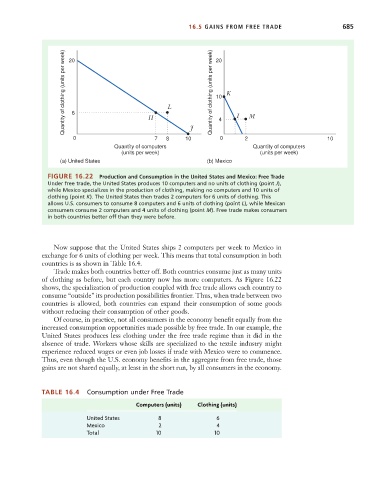Page 711 - Microeconomics, Fourth Edition
P. 711
c16GeneralEquilibriumTheory.qxd 8/16/10 9:14 PM Page 685
16.5 GAINS FROM FREE TRADE 685
Quantity of clothing (units per week) 20 6 L Quantity of clothing (units per week) 20 K I M
10
0 H 7 8 10 J 4 0 2 10
Quantity of computers Quantity of computers
(units per week) (units per week)
(a) United States (b) Mexico
FIGURE 16.22 Production and Consumption in the United States and Mexico: Free Trade
Under free trade, the United States produces 10 computers and no units of clothing (point J),
while Mexico specializes in the production of clothing, making no computers and 10 units of
clothing (point K). The United States then trades 2 computers for 6 units of clothing. This
allows U.S. consumers to consume 8 computers and 6 units of clothing (point L), while Mexican
consumers consume 2 computers and 4 units of clothing (point M). Free trade makes consumers
in both countries better off than they were before.
Now suppose that the United States ships 2 computers per week to Mexico in
exchange for 6 units of clothing per week. This means that total consumption in both
countries is as shown in Table 16.4.
Trade makes both countries better off. Both countries consume just as many units
of clothing as before, but each country now has more computers. As Figure 16.22
shows, the specialization of production coupled with free trade allows each country to
consume “outside” its production possibilities frontier. Thus, when trade between two
countries is allowed, both countries can expand their consumption of some goods
without reducing their consumption of other goods.
Of course, in practice, not all consumers in the economy benefit equally from the
increased consumption opportunities made possible by free trade. In our example, the
United States produces less clothing under the free trade regime than it did in the
absence of trade. Workers whose skills are specialized to the textile industry might
experience reduced wages or even job losses if trade with Mexico were to commence.
Thus, even though the U.S. economy benefits in the aggregate from free trade, those
gains are not shared equally, at least in the short run, by all consumers in the economy.
TABLE 16.4 Consumption under Free Trade
Computers (units) Clothing (units)
United States 8 6
Mexico 2 4
Total 10 10

